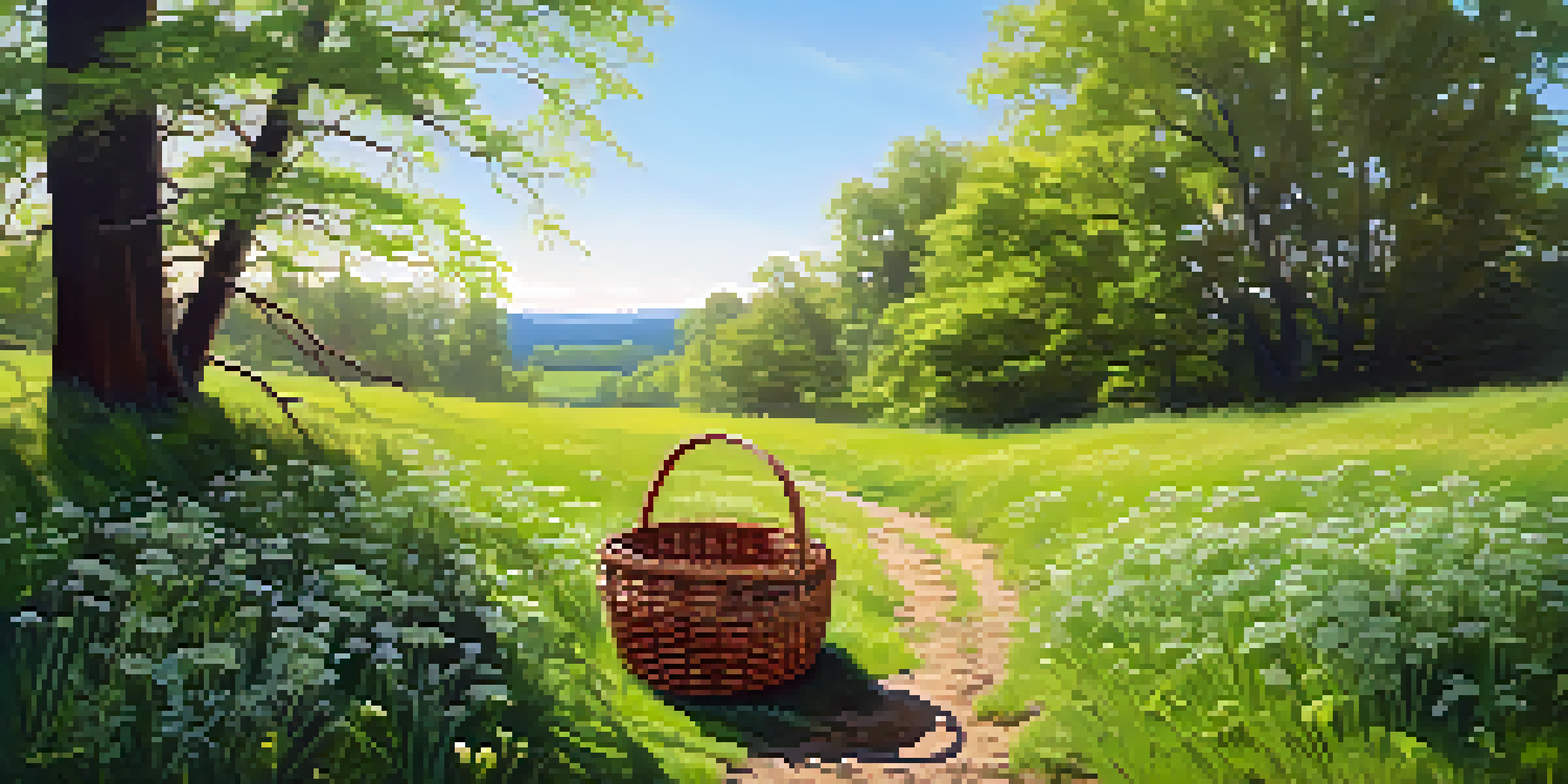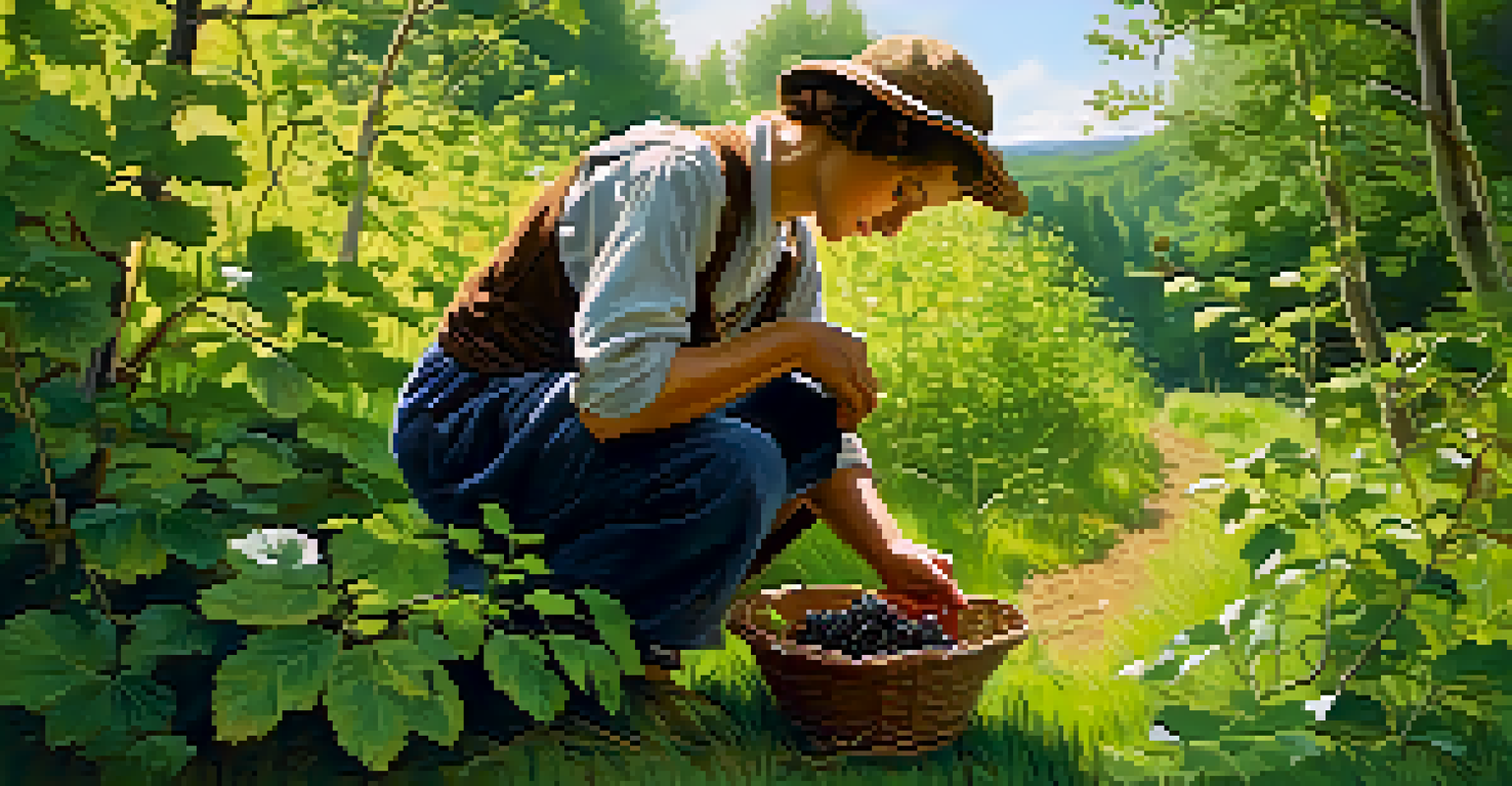A Seasonal Guide to Foraging: What to Pick Year-Round

Understanding the Basics of Foraging
Foraging is the act of gathering wild food resources from nature, which can be both fun and rewarding. It connects you with your environment and offers a sustainable way to source food. Before you start, it's crucial to educate yourself about local plants and fungi, as not all are safe or edible.
In every walk with nature one receives far more than he seeks.
You might compare foraging to treasure hunting, where knowledge is your map. Just as you wouldn’t venture into the unknown without directions, understanding the ecosystem around you is key to a successful foraging experience. This foundation can help you avoid toxic look-alikes and ensure you enjoy nature's bounty safely.
Many communities offer foraging workshops or resources to help beginners. Use these opportunities to learn from experienced foragers and build confidence in your skills. Remember, the more you know, the more likely you are to enjoy the fruits of your labor!
Spring Delights: What to Forage in March, April, and May
As spring arrives, nature awakens, offering a plethora of edible treasures. Look for tender wild greens like dandelion leaves and chickweed, which are perfect for salads or cooking. Additionally, springtime is prime foraging time for ramps, a wild onion that adds a delightful flavor to dishes.

You can think of spring foraging as a fresh start, much like new beginnings in life. The landscape transforms with vibrant colors and scents, encouraging you to explore and experiment in the kitchen. Just be mindful of sustainable practices; only harvest what you need and leave enough for wildlife and plant regeneration.
Foraging Connects Us to Nature
Foraging fosters a deeper connection to the environment, encouraging mindfulness and appreciation for natural ecosystems.
Foraging in spring is not just about food; it’s about reconnecting with nature. Spend time outdoors, breathe in the fresh air, and appreciate the beauty around you. This season is a celebration of life, and foraging can deepen your appreciation for the natural world.
Summer Bounty: Fruits, Fungi, and Herbs Galore
Summer is a forager's paradise, bursting with fruits, fungi, and herbs. Wild berries like blackberries and blueberries ripen, offering sweet snacks and delicious additions to your meals. You can also seek out mushrooms, such as chanterelles and morels, if you’ve done your homework on identification.
The greatest gift of the garden is the restoration of the five senses.
Imagine summer foraging as a picnic where nature provides the spread. The warmth of the sun and the sounds of wildlife create a perfect backdrop for gathering food. Just like a well-planned meal, foraging requires preparation and knowledge to ensure a successful outing.
Don’t forget about herbs! Wild mint, lemon balm, and stinging nettle are just a few examples that can enhance your culinary creations. As you forage, keep your senses open to the diverse flavors and aromas around you. Summer foraging can be an adventure that brings joy and nourishment.
Autumn Harvest: Nuts, Seeds, and More
As the leaves turn golden, autumn brings its own unique foraging opportunities. Nuts like acorns and chestnuts become available, perfect for roasting or incorporating into dishes. Additionally, gather seeds and late-season fruits, such as apples and persimmons, to enjoy their rich flavors.
Think of autumn foraging as preparing for winter. Just as animals gather and store food, you can take advantage of the natural abundance around you. This is a time to reflect on the changing seasons and the importance of preserving nature’s gifts for the colder months.
Seasonal Foraging Offers Diversity
Each season presents unique foraging opportunities, from wild greens in spring to nuts and mushrooms in autumn.
When foraging in autumn, be mindful of the ecosystem. Always harvest sustainably, ensuring that the plants and trees can continue to thrive. By respecting nature, you contribute to a cycle of renewal that benefits both you and the environment.
Winter Foraging: Surprising Finds in the Cold
Winter may seem like a barren time, but there are still foraging opportunities waiting to be discovered. Look for hardy greens like kale and wintercress, which can withstand the frost. Additionally, evergreen trees offer edible pine needles that can be used for tea or flavoring.
Think of winter foraging as uncovering hidden treasures beneath a blanket of snow. The landscape may appear quiet, but life persists in various forms. Embrace the challenge of finding food during this season, as it can lead to unexpected culinary delights.
Remember to dress warmly and be cautious of icy conditions while foraging. Winter can be unforgiving, but the rewards of fresh, wild food make the effort worthwhile. Plus, it’s a unique way to connect with nature in its calmest, most serene state.
Safety First: Tips for Safe Foraging
Safety is paramount when it comes to foraging. Always be 100% sure of your identification before consuming any wild food, as many plants and mushrooms have poisonous look-alikes. Investing in a good foraging guidebook or joining a local foraging group can help reinforce your knowledge.
Think of foraging as a culinary adventure where knowledge is your best friend. Just as you wouldn’t trust a recipe from an unknown source, you shouldn’t consume wild foods without thorough research. Taking the time to learn about what’s edible versus what’s not can save you from a potentially dangerous situation.
Safety is Crucial in Foraging
Identifying edible plants and mushrooms accurately is essential to avoid dangerous look-alikes and ensure a safe foraging experience.
Be cautious about the areas where you forage; avoid locations near roads or polluted sites. The health of your foraged food is just as important as its identification. By prioritizing safety, you can enjoy the thrill of foraging while keeping your health intact.
Preserving Your Foraged Foods: Tips and Techniques
Once you've gathered your foraged treasures, preserving them allows you to enjoy their flavors long after the season has passed. Techniques like drying, pickling, and freezing are excellent ways to extend the life of your wild foods. For example, dried mushrooms can be rehydrated and used in soups and stews.
Consider preservation as a way to bottle up the essence of each season. Just as a photograph captures a moment in time, preserving food allows you to savor summer’s berries or autumn’s nuts in the depths of winter. This connection to the seasons enhances your meals and memories.

Don’t forget to label your preserved items with the name and date. This practice not only helps you keep track of your stock but also adds a personal touch to your pantry. With a little creativity, you can transform your foraged finds into delightful gifts for friends and family.
Embracing the Foraging Lifestyle: More Than Just Food
Foraging is not just about gathering food; it’s a lifestyle that fosters a deeper connection to nature. By engaging in this practice, you develop an appreciation for the environment and its ecosystems. The simple act of gathering wild food can lead to greater mindfulness and respect for the earth.
Think of foraging as a journey rather than a destination. Each outing provides an opportunity to learn, explore, and grow. As you become more familiar with the land, you may find yourself more attuned to the rhythms of nature, which can be incredibly rewarding.
Embrace the community aspect of foraging as well. Share your experiences, recipes, and discoveries with others, fostering a sense of camaraderie among fellow foragers. This lifestyle can enrich your life in ways you never imagined, making each foraging trip an adventure filled with discovery.